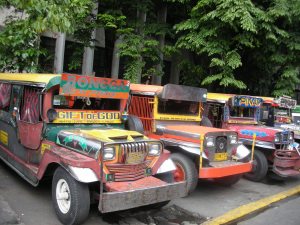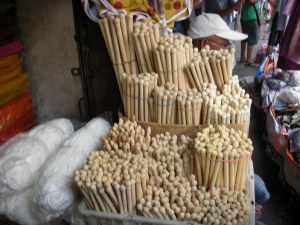An oxymoron is something that consists of incongruous, disparate or contradictory elements. For me, the word oxymoron describes Manila perfectly. And the first jarring disparity struck me almost the minute I stepped off the plane at Ninoy Aquino International Airport: namely the extreme juxtaposition between rich and poor.
On the one hand, the luxury lifestyle of the upper class inhabitants of gated communities like Dasmarinas, Forbes Park or Rockwell: the huge houses; the staff; the top of the range imported SUVs; the State of the Art schools for their kids. On the other hand there is the stark contrast of the cut and pasted tin shacks in shanty towns like Tondo, where there is no running water, erratic electricity and transport that consists of one’s feet, a rickety Pedicab or the brightly painted but antiquated jeepneys.  Schools? Well, let’s just say there is nothing State of the Art about the rough and ready orphanages for the homeless street kids.
Schools? Well, let’s just say there is nothing State of the Art about the rough and ready orphanages for the homeless street kids.
As I have become more familiar with Manila, so I have become more and more aware of its oxymoronic nature. Consider the weather. In the rainy season, the heavens open and the deluge could knock you off your feet. You wonder if the torrential downpour will ever cease as the typhoons rampage through the city, and the skies seem to be permanently overcast. You find yourself on the lookout for sandbags or an ark – even on the 32nd floor! And then suddenly it’s over, and for months the sky is crystal clear. Not a drop of rain. Not a whisper of a cloud.
Then there is the popular perception of the Filipinos as friendly and hospitable, the image of the ever-present smile, the warm ‘Mabuhay’. All of these are valid, but all are in sharp contrast to the ever-present security guard, the personification of suspicion and mistrust.
There he is at the entrance to every shopping mall, waving his magic baton over your bags in the expectation of finding a knife, a gun or perhaps a hand-grenade. Or alternatively the security guard that checks your shopping bags ten metres from the checkout, in case you have somehow managed to top up your shopping with pilfered goodies in those final five paces to the exit.
The most fascinating incongruity I have uncovered, however, is that of religion and capitalism. In the sixteenth century the Spanish colonists arrived and quickly converted the Filipinos to Catholicism. Since then, Manila has become a devout and devoted City of Churches. On a recent exploration I discovered more than half a dozen churches only a stone’s throw from our apartment, from the garishly gilded to the starkly simple. I have watched penitents crawl on their knees to the altar, and children decked out for their first communion. I have seen hearses crawling through the streets of Angeles while relatives and friends trailed behind on foot. I have queued at the airport while a woman tried to gently arrange the family saint through the scanner on its way home to the provinces for the All Saints day holiday. Four hundred years later Christianity is still alive and well in the Philippines.
Yet, at the beginning of the twentieth century, the Americans arrived to colonize and capitalize, and Manila also became a city of shopaholics and shopping malls.
But the Bible suggests that we can only serve one master, either God or Mammon; spirituality or greed and materialism. Jesus threw the shopkeepers out of the Temple. Still, in South Australia in the 1980s, the shops closed at noon on Saturday and didn’t re-open until nine o’clock on Monday morning. Sunday was a holy day; a day of rest quite separate from a weekday, and never the twain shall meet.
So imagine my surprise, during my first weekend in Manila, to discover a chapel on the top floor of the Power Plant Mall. The congregation had overflowed onto the concourse, where the faithful leaned on the railings listening to the service through loud-speakers while surreptitiously watching the shops and the shoppers out of the corner of their eyes.
Later I discovered Greenbelt mall. Arguably the most attractive shopping centre in Manila, Greenbelt consists of five buildings filled with fine restaurants, bars and designers shops, clustered around a lush green linear park. A chain of ponds run through the centre, bejewelled with goldfish, ducks and turtles.  And at the top end, like a hovering space ship or a giant water lily, is the Santa Niño del Paz Community church. On Sunday, this open air chapel fills and spills its congregation across the bridges into the park. Hymns waft through the air, and an unlikely peace descends on the park, the worshippers and the shoppers.
And at the top end, like a hovering space ship or a giant water lily, is the Santa Niño del Paz Community church. On Sunday, this open air chapel fills and spills its congregation across the bridges into the park. Hymns waft through the air, and an unlikely peace descends on the park, the worshippers and the shoppers.
Yet, while I may find this contradictory – church and mall intertwined – the Filipinos seem to take it in their stride and seem to see no incongruity in serving both God and Mammon. As reflected in their eclectic food culture and their heterogeneous race, Filipinos are adept at blending black and white into all shades of the rainbow. It is a national trait.
So a local website describes the Greenbelt chapel as ‘a blessed pause with the Lord for the busy office workers, the tired shoppers and the nearby dwellers.’ It is truly a piece of heaven in the middle of a shoppers paradise; spirituality in the midst of materialism. An oxymoron? Not in the Philippines!



